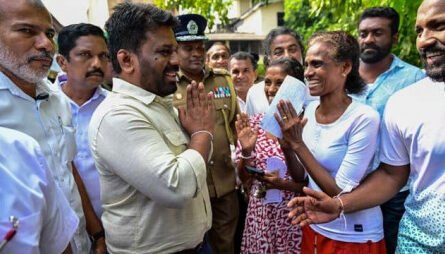An Israeli ground offensive in the southern Gazan enclave of Rafah is a question of when, not if. Not because Prime Minister Binyamin Netanyahu is oblivious to US and international pressure but because it could prove to be make or break for Israel’s embattled leader.
Netanyahu has promised “total victory” in the Gaza war and to “finish the job” in Rafah.
The stakes for Netanyahu could not be higher. The assault on Rafah, home to more than a million Palestinians displaced by the war, could determine whether and to what degree Israel’s military achieves Netanyahu’s three war goals.
Israel suspects that Hamas’ top Gaza-based leaders, including Yahya Sinwar, Israel’s most wanted man, are hiding in tunnels under Gaza, shielded by the surviving Hamas-held Israeli and foreign national hostages.
Hamas and other Palestinians abducted 250 people during the group’s October 7 attack. Hamas released more than 100 of the captives in November in a Qatar-mediated exchange for 240 Palestinians incarcerated in Israel. An unknown number of the remaining hostages were since killed in the fighting.
Netanyahu has vowed to prosecute war until Israeli forces have destroyed Hamas, freed Hamas-held Israeli and foreign national hostages, and ensured that Gaza no longer is a launching pad for Palestinian resistance.
At first glance, things do not look good for the Israeli leader.
Despite its devastating human and physical cost, Israel’s effort to destroy Hamas has a whack-a-mole aspect.
Even though Israel asserts it has killed 13,000 of Hama’s estimated 40,000 fighters and wounded or captured thousands more, Hamas retains a presence in swaths of Gaza.
It has been able to re-establish itself, to varying degrees, in areas Israel says it has largely cleansed of Hamas militants and other armed Palestinian groups.
Similarly, seven months into the war, Israel has killed only one of Hamas’ most senior Gaza-based leaders, Marwan Issa, the deputy head of the group’s military wing.
Finally, despite Netanyahu’s assertions that military force is needed to free hostages, the fact is that the vast majority of released captives were liberated as the result of negotiations and part of a ceasefire.
Two unidentified Israel ceasefire and prisoner exchange negotiators accused Netanyahu earlier this month of undermining Qatari-mediated negotiations by refusing to entertain creative ideas, reversing war cabinet decisions, and imposing demands the prime minister knew Hamas would reject.
One of the negotiators said Netanyahu’s office conveyed an attitude of “cold indifference” toward the hostages.
The other negotiator added, “I can’t say that without Netanyahu, there would have been a deal, but I can say that without Netanyahu, the chances of making a deal would be better.”
While Netanyahu has insisted that he will launch an offensive irrespective of what the United States and the international community say, he appears to take fears of mass civilian casualties into account.
US and Israeli officials have suggested that instead of a massive ground offensive, Israel may attack in a more targeted form.
That could involve a neighbourhood-by-neighbourhood assault, allowing the Israelis to evacuate Palestinian civilians in phases, which would make moving people out of harm’s way more feasible.
Recent satellite images show rows of tents in two new encampments erected earlier this month, one to the west of Khan Younis and the other near Rafah.
Israeli media reported that Israel was buying 40,000 tents that could hold 10 to 12 people each to prepare for the evacuation of Palestinian civilians from Rafah.
The outcome of the Rafah offensive is likely to reverberate beyond Gaza.
It could impact the course of hostilities along the Israeli-Lebanese border between Israel and Hezbollah, the Iran-backed Lebanese Shiite Muslim militia, irrespective of whether Israel succeeds or fails.
The offensive could put Hezbollah between a rock and a hard place, given that neither Iran nor substantial segments of Lebanon’s multi-ethnic, multi-religious population want to be drawn into an all-out war with Israel.
“Our main goal was and remains to ensure that a different security situation prevails here and that the residents of Israel’s north can return to their homes in peace and safety. We are dealing with a number of alternatives…and the coming period will be decisive,” Israeli Defence Minister Yoav Gallant said while touring the Israeli-Lebanese border earlier this week.
Tens of thousands of Israelis have evacuated the border region since the Gaza war erupted after Hezbollah, in solidarity with Hamas, initiated hostilities calibrated to tie up Israeli forces in the north without provoking an all-out war.
An Israeli failure in Rafah to achieve Netanyahu’s objectives could persuade the prime minister to take on Hezbollah alongside continuing its campaign in Gaza in a bid to force the group to withdraw to 30 kilometres from the Israeli border to north of the Litani River.
On the other hand, an Israeli capture or killing of Sinwar and other top Gaza-based Hamas leaders, the defeat of four of the group’s six remaining brigades, which Israel claims are based in Rafah, and the freeing of Hamas-held hostages could put Hezbollah in a difficult spot.
Sticking to its promise to end the hostilities in Gaza once there is a ceasefire, probably on Israel’s terms, would amount to acquiescing in Hamas’ defeat.
Said hardline Israeli historian Benny Morris: “To now allow the badly mauled Hamas to emerge victorious will underline Zionism’s crucial failure. And critics in the Arab and Muslim world of making peace with Israel…may well be emboldened to reject such ties.”
Also published on Medium.


